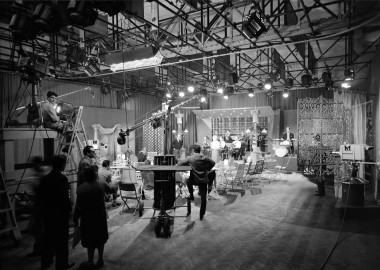
The following is adapted from a speech given at the Global Civic Public Salon, on some future directions and threats I see for the industry of print and broadcast journalism. While I started out interested in considering economic factors, my thoughts became increasingly personal as my research progressed. Here are the results of that hybridized thinking. Some of these insights began for me when I wrote a post called “How I Learned to Stop Worrying and Love Storytelling.”
I worked in traditional media for about 25 years, most recently as editor in chief of Vancouver magazine. Before that I was managing editor of the alt-weekly the Georgia Straight for about a decade. About a year ago, I veered left and joined a local agency named ECHO Storytelling Agency that uses storytelling and the techniques of journalism to solve marketing problems. I’ll talk a little about that in a moment.
 I got into journalism by a funny route. Here’s a CompuGraphic 8600, a typesetting machine that predates desktop publishing. This is the first computer I ever did real work on. I wasn’t a writer in those days, but made ads and laid out pages in the production department. Stories and ads were typed into these behemoths and then printed out on strips of paper, waxed to cardboard, and ultimately photographed for the press.
I got into journalism by a funny route. Here’s a CompuGraphic 8600, a typesetting machine that predates desktop publishing. This is the first computer I ever did real work on. I wasn’t a writer in those days, but made ads and laid out pages in the production department. Stories and ads were typed into these behemoths and then printed out on strips of paper, waxed to cardboard, and ultimately photographed for the press.
Coming out of university with a degree in French and Spanish linguistics I wasn’t exactly job ready, but my early years of typesetting did actually train me for a job. I apprenticed with a master typesetter, sat tests, and became a journeyman in the Communications Energy & Paperworkers union. So this world, with formal on-the-job training and standardized testing — this was how I got into journalism and what I understood journalism to be.
By the way, I have no idea if journeyman typesetter remains a viable career path, but I imagine competition these days can’t be that stiff.
 Here’s the world we’re in now. This is Mario Lopez, Jr. from Dancing With the Stars. This is a sponsored tweet he sent out for Kellogg’s. Many people say this kind of monkeyshines is what killed mainstream media: advertisers no longer need to buy premium ad space, and what space they do buy — so-called programmatic advertising they rent from eyeball companies like Facebook and Google — is so vanishingly cheap that media giants can’t make a buck any more. So Mario Lopez, and thousands of people like him, stole all the gold from their treasury.
Here’s the world we’re in now. This is Mario Lopez, Jr. from Dancing With the Stars. This is a sponsored tweet he sent out for Kellogg’s. Many people say this kind of monkeyshines is what killed mainstream media: advertisers no longer need to buy premium ad space, and what space they do buy — so-called programmatic advertising they rent from eyeball companies like Facebook and Google — is so vanishingly cheap that media giants can’t make a buck any more. So Mario Lopez, and thousands of people like him, stole all the gold from their treasury.
You might think I’m about to bang on about how terrible this all is. Oh, technology. The end of daily newspapers. The concentration of media in the hands of a few oligarchs. The decline in reporting. The confusion of news and gossip. The decline in political literacy. The rise of Donald Trump. Those are all terrible things, but I don’t think this is technology’s fault. The average Canadian spends 65 minutes online every day, and I’m way above that. I tweet and Facebook and Snapchat like everyone. I do have a problem with quality, though. We’re in such a rush, we’ve become lazy — but that’s not technology’s fault.
My beef is with the change not in technology but in us. Harassed by online, we’ve embraced metrics as a way to reintroduce quality into our discourse. Yet our obsession with audience, with capturing engagement and increasing engagement and selling against engagement, is where I see journalism eroding, and eroding fast.
Our obsession with audience, with capturing engagement and increasing engagement and selling against engagement, is where I see journalism eroding, and eroding fast.
That CompuGraphic prehistory I talked about was only 25 years ago. Now we have iPhones, soon driverless cars. But the shift that really floors me is what is coming to replace the so-called mainstream media –and its editors, who published stories that they believed would be of interest to the “common man.”
 Here’s the first story I ever published. The journal was about theatre in Canada and the story was about how seniors were creating political protest theatre. I got $300. And here’s my first proper journalism job. I was a reporter for the Burnaby News. I covered city hall, then I was the arts editor, business editor, sports editor, op-ed writer.
Here’s the first story I ever published. The journal was about theatre in Canada and the story was about how seniors were creating political protest theatre. I got $300. And here’s my first proper journalism job. I was a reporter for the Burnaby News. I covered city hall, then I was the arts editor, business editor, sports editor, op-ed writer.
 Just for the fun of it, here’s my business card from back in the day, say 1995. Everything you see is now defunct. The paper is dead, the MetroValley Newspaper Group is dead, I don’t imagine anyone has the title “reporter,” meaning full-time print writer, anymore. There’s a fax number. It’s a business card.
Just for the fun of it, here’s my business card from back in the day, say 1995. Everything you see is now defunct. The paper is dead, the MetroValley Newspaper Group is dead, I don’t imagine anyone has the title “reporter,” meaning full-time print writer, anymore. There’s a fax number. It’s a business card.
Back at the Burnaby News I had a good sense of what made a valuable story: something new was happening in Burnaby. Not difficult. Today, every story goes to a world audience. Everything is uploaded in real time. Everybody has the tools of the trade, a cellphone camera, a keyboard. Engagement stretches a little thin…
 This is Ted Sarandos, Chief Content Officer for Netflix. Netflix has become extremely successful by applying audience metrics to broadcast television. He’s responsible for the invention of a new kind of entertainment, specifically House of Cards, but dozens of other streaming shows as well, that will pound one more nail in the coffin of traditional broadcast TV. He swims in big data, yet here’s what he says: trust your gut. Why? Because there’s still a gap between AI thinking and human thinking. Because we make erratic viewing choices when we come home drunk at 3 in the morning. Because we are inconsistent. Our moods shift. We are happy not always knowing ourselves.
This is Ted Sarandos, Chief Content Officer for Netflix. Netflix has become extremely successful by applying audience metrics to broadcast television. He’s responsible for the invention of a new kind of entertainment, specifically House of Cards, but dozens of other streaming shows as well, that will pound one more nail in the coffin of traditional broadcast TV. He swims in big data, yet here’s what he says: trust your gut. Why? Because there’s still a gap between AI thinking and human thinking. Because we make erratic viewing choices when we come home drunk at 3 in the morning. Because we are inconsistent. Our moods shift. We are happy not always knowing ourselves.
Speaking of data, these charts are from an excellent report from earlier this year by Madelaine Drohan. The report is called “Does Serious Journalism Have a Future in Canada?” and in it she draws on research about media concentration to show — on the left — who supplied the content of internet news, up to 2014. Top right are the Big 4 — CBC, Quebecor’s Canoe, the Weather Network, and About.com — accounting for 30% of the online ideas market in Canada. Top left, the bottom 13 also account for 30% and include names you’d more likely associate with news: Global, New York Times, Rogers…
On the right, who gets the money? Again, these are 2014 data. Google, Facebook… And here in this tiny corner, names you’d recognize, Rogers, the Globe, Torstar, etc. Together, they’re a 10th. But hey, boring! This is my dog, Deirdre. She’s just been spayed, so she’s wearing the cone and looking a little dopey.
And here’s Deirdre as that pie chart of revenue. Over time, this dog chart will simplify, I’m sure, as Google and Facebook swallow everyone else. Or something else comes along and eats them all. What’s to be done? I would argue we need to think deeply about the idea and value of engagement.
How many times a day do we actually want and need to engage with other people? If it’s to gossip about celebrity wardrobe malfunctions and sexual indiscretions, the Tinder-ization of information, I guess there’s no limit. But let’s not call all the sharable, snackable, ephemeral stuff that social networks or media networks or whatever Twitter and Facebook and Google want to call themselves — let’s not call that journalism.
Let’s not call all the sharable, snackable, ephemeral stuff that social networks or media networks or whatever Twitter and Facebook and Google want to call themselves — let’s not call that journalism.
And on the other hand, the kind of square, traditional, legacy, mainstream serious, public good journalism that I believe contributes to meaningful involvement in society and good citizenship. Let’s call that journalism. That’s romance, wedding bells, a life together. That’s deep, one-on-one engagement.
I think that journalism, so defined, should be a public benefit like clean drinking water, plentiful public parks, a functioning judiciary, etc. I think that deserves respect and financial support and awards, the way documentary filmmaking is treated now.
And through some mechanism left to smarter people than me, I think journalism should be supported not by clicks and retweets and sponsors, but by a governmental tax framework that helps us to be better than we’re often tempted to be.
For myself, I’m living happily ever after. I revel in not stressing out at work every day about whether a million strangers Like and Share every word I write. In my current job we spend a ton of time identifying the specific audience for each project we take on, and we labour hard to build enduring paths to what should be the goal of every writer: pleasing not everyone a little bit, but the right people a whole lot.





